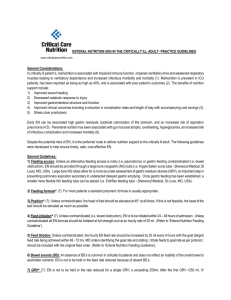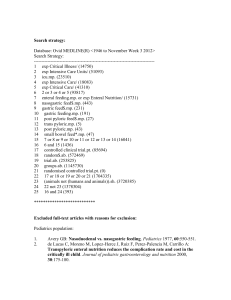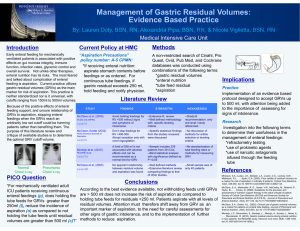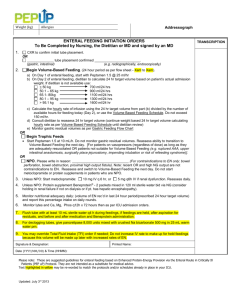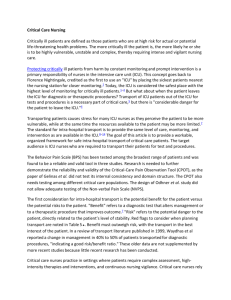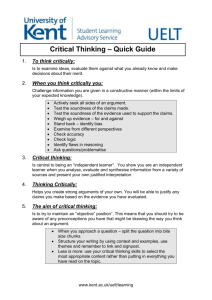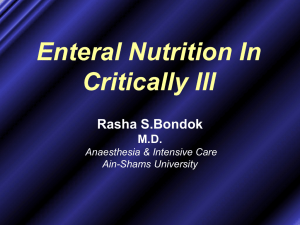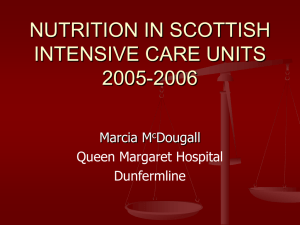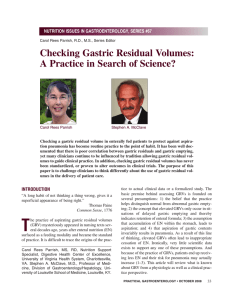Nibble 9 - GRVs - Critical Care Nutrition
advertisement
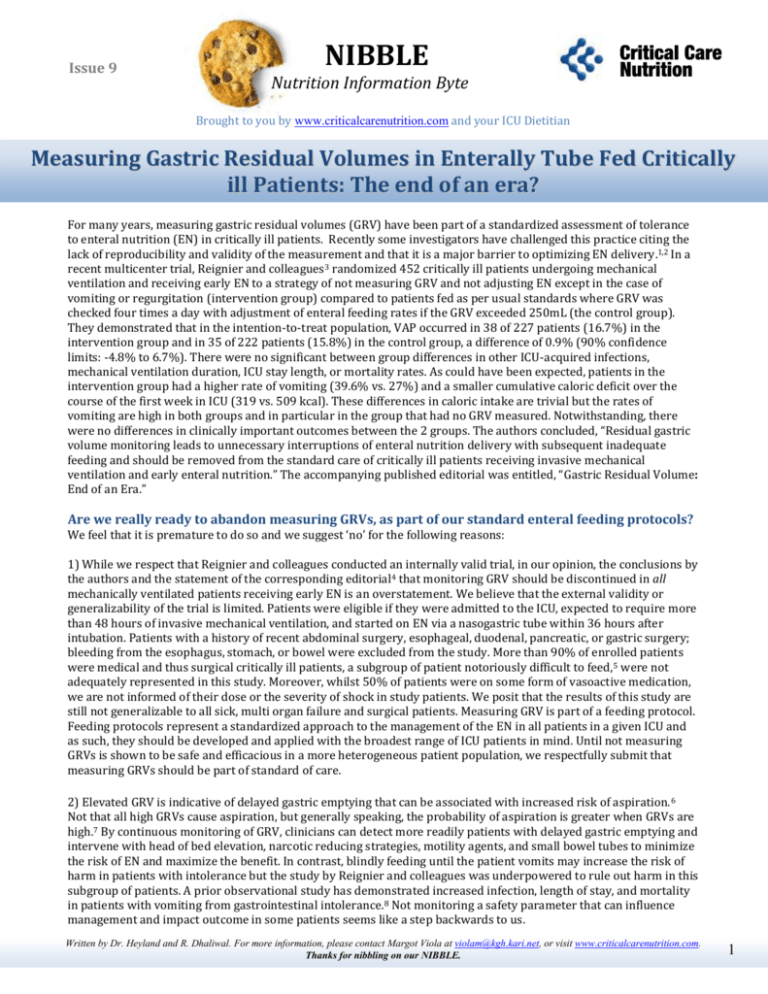
Issue 9 NIBBLE Nutrition Information Byte Brought to you by www.criticalcarenutrition.com and your ICU Dietitian Measuring Gastric Residual Volumes in Enterally Tube Fed Critically ill Patients: The end of an era? For many years, measuring gastric residual volumes (GRV) have been part of a standardized assessment of tolerance to enteral nutrition (EN) in critically ill patients. Recently some investigators have challenged this practice citing the lack of reproducibility and validity of the measurement and that it is a major barrier to optimizing EN delivery.1,2 In a recent multicenter trial, Reignier and colleagues3 randomized 452 critically ill patients undergoing mechanical ventilation and receiving early EN to a strategy of not measuring GRV and not adjusting EN except in the case of vomiting or regurgitation (intervention group) compared to patients fed as per usual standards where GRV was checked four times a day with adjustment of enteral feeding rates if the GRV exceeded 250mL (the control group). They demonstrated that in the intention-to-treat population, VAP occurred in 38 of 227 patients (16.7%) in the intervention group and in 35 of 222 patients (15.8%) in the control group, a difference of 0.9% (90% confidence limits: -4.8% to 6.7%). There were no significant between group differences in other ICU-acquired infections, mechanical ventilation duration, ICU stay length, or mortality rates. As could have been expected, patients in the intervention group had a higher rate of vomiting (39.6% vs. 27%) and a smaller cumulative caloric deficit over the course of the first week in ICU (319 vs. 509 kcal). These differences in caloric intake are trivial but the rates of vomiting are high in both groups and in particular in the group that had no GRV measured. Notwithstanding, there were no differences in clinically important outcomes between the 2 groups. The authors concluded, “Residual gastric volume monitoring leads to unnecessary interruptions of enteral nutrition delivery with subsequent inadequate feeding and should be removed from the standard care of critically ill patients receiving invasive mechanical ventilation and early enteral nutrition.” The accompanying published editorial was entitled, “Gastric Residual Volume: End of an Era.” Are we really ready to abandon measuring GRVs, as part of our standard enteral feeding protocols? We feel that it is premature to do so and we suggest ‘no’ for the following reasons: 1) While we respect that Reignier and colleagues conducted an internally valid trial, in our opinion, the conclusions by the authors and the statement of the corresponding editorial 4 that monitoring GRV should be discontinued in all mechanically ventilated patients receiving early EN is an overstatement. We believe that the external validity or generalizability of the trial is limited. Patients were eligible if they were admitted to the ICU, expected to require more than 48 hours of invasive mechanical ventilation, and started on EN via a nasogastric tube within 36 hours after intubation. Patients with a history of recent abdominal surgery, esophageal, duodenal, pancreatic, or gastric surgery; bleeding from the esophagus, stomach, or bowel were excluded from the study. More than 90% of enrolled patients were medical and thus surgical critically ill patients, a subgroup of patient notoriously difficult to feed, 5 were not adequately represented in this study. Moreover, whilst 50% of patients were on some form of vasoactive medication, we are not informed of their dose or the severity of shock in study patients. We posit that the results of this study are still not generalizable to all sick, multi organ failure and surgical patients. Measuring GRV is part of a feeding protocol. Feeding protocols represent a standardized approach to the management of the EN in all patients in a given ICU and as such, they should be developed and applied with the broadest range of ICU patients in mind. Until not measuring GRVs is shown to be safe and efficacious in a more heterogeneous patient population, we respectfully submit that measuring GRVs should be part of standard of care. 2) Elevated GRV is indicative of delayed gastric emptying that can be associated with increased risk of aspiration. 6 Not that all high GRVs cause aspiration, but generally speaking, the probability of aspiration is greater when GRVs are high.7 By continuous monitoring of GRV, clinicians can detect more readily patients with delayed gastric emptying and intervene with head of bed elevation, narcotic reducing strategies, motility agents, and small bowel tubes to minimize the risk of EN and maximize the benefit. In contrast, blindly feeding until the patient vomits may increase the risk of harm in patients with intolerance but the study by Reignier and colleagues was underpowered to rule out harm in this subgroup of patients. A prior observational study has demonstrated increased infection, length of stay, and mortality in patients with vomiting from gastrointestinal intolerance.8 Not monitoring a safety parameter that can influence management and impact outcome in some patients seems like a step backwards to us. Written by Dr. Heyland and R. Dhaliwal. For more information, please contact Margot Viola at violam@kgh.kari.net, or visit www.criticalcarenutrition.com. Thanks for nibbling on our NIBBLE. 1 Issue 8 NIBBLE Nutrition Information Byte Perhaps the more pertinent question is: What is the most appropriate level of GRV that should be used to manage EN delivery? Is it 200ml? Is it 500ml? Or is it somewhere in between? Montego and colleagues9 randomized 329 enterally fed, mechanically ventilated patients to a feeding protocol with a threshold volume of 200 vs. 500 ml. Nutritional intake, pneumonia rates, duration of mechanical ventilation and other clinical outcomes were the same between the 2 groups. Again, while this trial has a high degree of internal validity, it lacks external validity or generalizability to other populations. Patients in both groups tolerated over 85% of their prescribed calories, amounts not seen in many audits of clinical practice and suggestive of the fact that difficult to feed patients were excluded from this trial (not an adequate description of patients enrolled in the trial, no description of use of vasoactive medications and less than 5% had a surgical diagnosis). All patients received prophylactic use of a motility agent for the first 3 days, a practice not common in many settings. Perhaps in patients at low risk of gastrointestinal intolerance that are receiving prophylactic motility agents, it does not matter what level of GRV used to manage the EN (either 200 or 500mL), but for other patient populations at high risk of intolerance, or if not using prophylactic motility agents, the use of a high GRV threshold of 500mL may be associated with increased complications and a missed opportunity to intervene to minimize the risk of aspiration. Using a lower GRV (200300ml) will enable practitioners to monitor and detect signs of delayed gastric emptying and intervene with strategies to minimize the risks of EN (as explained above). In the end, it will be up to local ICUs to determine what number to use (between 200-500mL) based on consideration of their local customs, patient population and practice patterns (use of prophylactic motility agents). The bottom line is that somewhere between 200-500ml is defensible, as long as some monitoring of GRVs is routinely done! The Canadian Clinical Practice Guidelines will be updated in March 2013! The new guidelines will be posted under the 'Practice Guidelines 2012' section on www.criticalcarenutrition.com References McClave SA, Sexton LK, Spain DA, et al. Enteral tube feeding in the intensive care unit: factors impeding adequate delivery. Crit Car Med 1999;27(7):1252-1256. 2 McClave SA, Lukan JK, Stefater JA, et al. Poor validity of residual volumes as a marker for risk of aspiration in critically ill patients. Crit Care Med 2005;33(2):324-330. 3 Reignier J, Mercier E, Le Gouge A, et al. Effect of not monitoring residual gastric volume on risk of ventilator-associated pneumonia in adults receiving mechanical ventilation and early enteral feeding: a randomized controlled trial. JAMA. 2013;(3):249-256. 4 Rice TW. Gastric residual volume: end of an era. JAMA 2013 Jan 16;309(3):283-4.doi: 10.1001/jama.2012.216616. 5 Drover JW, Cahill NE, Kutsogiannis J, et al. Nutrition therapy for the critically ill surgical patient: We need to do better! JPEN J Parenter Enteral Nutr 2010;34:644-652. 6 Chapman MJ, Besanko LK, Burgstad CM, et al. Gastric emptying of a liquid nutrient meal in the critically ill: relationship between scintigraphic and carbon breath test measurement. Gut 2011;60:1336-1343. 7 Metheny NA, Schallom L, Oliver DA, Clouse RE. Gastric residual volume and aspiration in critically ill patients receiving gastric feedings. Am J Crit Care 2008;17:512-520. 8 Mentec H, Dupont H, Bocchetti M, Cani P, Ponche F, Bleichner G. Upper digestive intolerance during enteral nutrition in critically ill patients: frequency, risk factors, and complications. Crit Care Med. 2001;29(10):1955-1961. 9 Montejo JC, Minambres E, Bordeje L et al. Gastric residual volume during enteral nutrition in ICU patients: the REGANE study. Intensive Care Med 2010;36:1386-1393. Written by Dr. Heyland and R. Dhaliwal. For more information, please contact Margot Viola at violam@kgh.kari.net, or visit www.criticalcarenutrition.com. Thanks for nibbling on our NIBBLE. 2
